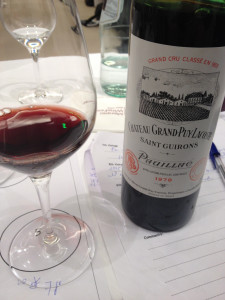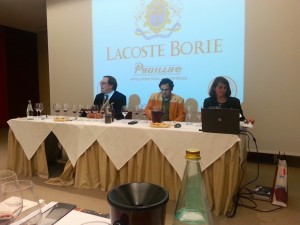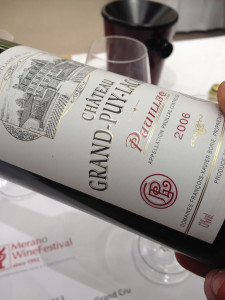Grand Puy Lacoste: most masterful fifth
November 27, 2013
By Panos Kakaviatos
Several years ago, I published an article in Decanter on competition among various fifth growths in Pauillac. For at least 30 years already, Lynch Bages has been called the “Poor Man’s Mouton” – although chateau owners sometimes refer to Mouton as the “Rich Man’s Lynch Bages.”
Well, since then, many other fifths from Pauillac have been raising their game.
Perhaps the most recently famous of them all is Pontet Canet, whose prices – in top vintages – rival most super seconds. Critical praise, from Robert Parker and many others, has only reinforced the price hikes.
But others, too, have been striving more to achieve better quality in recent years.
Take Haut Bages Liberal. It has always been a “solid” Pauillac, but in recent years, it has grown more precise. In a blind tasting I had organized for wine specialists to write my article in Decanter, the Haut Bages Liberal 1990 came in third, just after Lynch Bages and Grand Puy Lacoste.
An arguably stronger performance comes from Batailley. I have always had a soft spot for Batailley – the 1996 vintage comes to mind – and recently co-presented three verticals in Germany – on 21, 22 and 23 November – of 10 vintages spanning over three decades. Tasters from all walks of life – merchants, bloggers and wine lovers – generally praised the critically acclaimed 2009, but also vintages like 2005, 2004 and 2003. Batailley’s new cellar master since that last vintage, Arnaud Durand, has been more carefully sorting grapes and increases precision in the vat room.
Since 2006, he has been fermenting grapes from specific parcels with corresponding vats to make more harmonious wines.
But my fifth growth darling remains Château Grand Puy Lacoste.
Sure, its prices have gone up – but not nearly as much as the comparable Lynch Bages. Indeed, both estates share similar terroir. Arguably Lynch Bages had been more caught up in the China Fever two years ago – leading to absurd prices for recent vintages.
Not so GPL. Older vintages like 2000 are half the price of Lynch Bages, and GPL is just as good in that vintage. Sometimes, it is better, because Lynch Bages tends to pick later and extracts more tannin and ages the wine in more new oak. So, for me, a lover of freshness in wine, GPL is the ticket.
The tasting on 9 November 2013 took place at the magnificent Merano Wine Festival. Thanks to friend and project manager Ian d’Agata, I was able to co-host this tasting of 10 vintages spanning from 1978 to 2008 in a “master class” for a select group of wine connoisseurs. We were joined by co-owner Emeline Borie. The tasting confirmed once again the general finesse, excellent Pauillac grip, density and above all freshness coming from this estate.
To the tasting notes: when in bold, I liked particularly. If red and bold, even more. When underlined too, tis nearly heaven.
2008: Lovely nose, salty, fresh cranberry aspects, ripe and not overripe, substantial mid palate, tannin more evident on the finish. Both Ian and I were very impressed with the GPL in 2008, which is not an easy vintage – sometimes marked in other wines by under-ripe notes and high acidity. Still, fine weather in July helped ripen the grapes and the Cabernet was able to benefit from the long Indian Summer in spite of a cold and cloudy August. Nearly 70% Cabernet and the rest Merlot.
2006: A higher proportion of Cabernet in this vintage – closer to 80% – and it seems a bit closed, like other 2006s these days. The nose is not as expressive. Aeration brings forth notes of licorice and dark cherry and cassis. It is certainly substantial on the mid palate – more so than the 2008 – with graphite notes on the finish. Overall, closed and perhaps not as bright an expression as the 2008. Cellaring highly recommended.
2005: The nose is akin to perfume. There is such beautiful intensity and focus, almost a floral aspect with powerful and imposing tannin on the palate but suave on the full bodied mid palate, happily balanced by freshness. But far too young to touch today – as we shall see…
2001: The color noticeable bricking on the outer layer. There is a hint of leafy earth on the nose, a touch of champignon but just a touch. The mid palate is of medium intensity but croquant – crispy – and even though the finish is marked by slightly austere tannins, the acidity combined with tertiary medium substance palate makes this ready for the dinner table: I would order a rib eye.
2000: An overall smoother and sweeter impression. No jagged tannins here. Aromas marked by camphor and a touch of iron, creosote. Much going on with aeration, and the medium plus body envelopes the palate with touches of dark fruit and spice towards the lingering finish which has some tannic edginess to it, recalling that this is still too young to be fully resolved. I dare say that it may even be in a slightly closed phase. Great potential!
1999: Wow, this is a mild revelation. Robert Parker compared the 99s to 62s a long time ago. This comparison makes sense here. The wine is smooth and drinkable. Much softer than the 2000 and zero austerity on the finish, that we get in the 2001 – a somewhat comparable vintage. I recall tasting the 2001 and 1999 side by side back in 2003 and the 2001 then seemed to show more promise. But 10 years later, the 1999 is juicier and more pleasing than the 2001. Recommended for current drinking.
1998: Here we have a wine that is more substantial on the palate than the 1999, showing more weight. It has a salty freshness too. And while I enjoyed it, I think it will be better with more time in the cellar, albeit with some edgy tannins – “it rained cats and dogs during the harvest,” Emeline said. Perhaps like the 2000, but not as spherical, this 1998 just needs time to settle down. Too young.
1995: When we got to this vintage, it was my favorite. The nose was like a red fruit basket – very expressive. And in spite of being almost 20 years old, it seemed quite youthful and substantial too. But where the 1998 showed weight, the 1995 showed weight with more finesse and elegance. The grain of the tannin is finer here, and the grip on the palate impressive: a rather “contained opulence” that makes me wonder if it has even yet reached its optimal drinking plateau. Just a great wine!
1979: This was not a super vintage in Bordeaux, but some estates performed well, or better than expected. GPL falls into both categories. Yes, it is bricking more than just on the rim, and displays an earthy and leafy aspect – underbrush – but there is pleasure to be had here. Of medium minus body at this point, with acidity to make it fine with your meal. The finish is a touch pinched.
1978: What is it that people say as wine reaches a certain age: “There are no longer good wines, but good bottles.” I have had this vintage before, at the chateau, and this bottle was better. 1978 was also the first vintage for Francois Xavier Borie. He did a great job. The vintage was good, not great. A late spring led to an erratic summer. The vintage was saved by excellent early autumn weather and as a consequence some very good wines. This bottle was very fresh tasting and more youthful than its years would suggest, displaying a typical cigar box aspect from aged Cabernet, and the finish, sneakily persistent, marked by a fresh lift of mint. Just a lovely bottle of wine, and perhaps the best of the tasting for current drinking. I went back to the 1995 and – by comparison – the 1995 is overly tannic: hardly ready to drink today!
Although the mainly Italian participants picked the 1995, 2005 and 2000 as the most popular of the tasting – in that order – they also appreciated a consistent freshness in GPL. I cannot agree more.
Overall, GPL is my favorite fifth growth Pauillac, when considering both price and quality.





Panos,
I think you need to taste more 1979s. There are so many really good wines, particularly Pomerol and Margaux, but I keep finding other wines that surprise.
When I am in New York sometime in January, let’s arrange an offline for 1979s.
Panos,
could you draw a comparison between GPL 2010 and 2005?
Christian, we did not try the 2010 in November this year, but based on tasting the GPL 2010 earlier this year, I would say that they are more similar than different. The chateau likes to say that 2010 is “better” – as most chateaux would. In terms of measurable units, the 2010 may well have more tannin, and a structure that is more evident. But I am not sure that they are that much different, in that the 2005 when tasted just from bottle, was also quite tannic and structured – and it still is. Perhaps just slightly rounder in impression? In my book, both are long term keepers. So, for earlier drinking, marginally speaking, go for the 2005. In terms of price, not too much difference.
2000 was one of the finest post war vintages for Piedmont wines. The wines are still tannic and youthful. i have regularly drink this wine and enjoyed a lot…